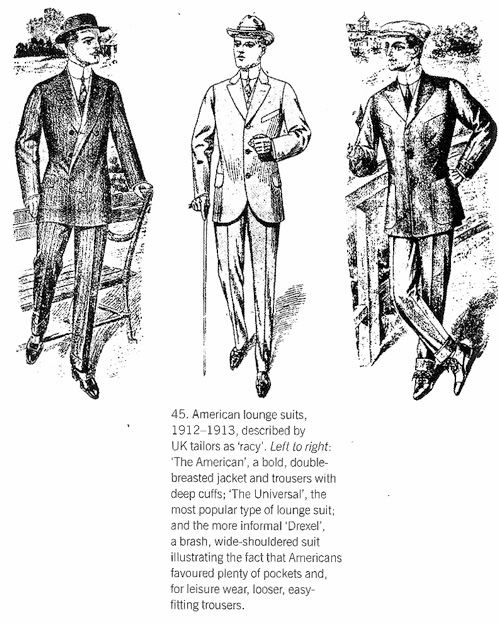If you would dress like a gentleman, you must do one of two things; either study the subject of a gentleman’s wardrobe until you are competent to pick out good suits from freaks and direct your misguided tailor, or, at least until your perceptions are trained, go to an English one. This latter method is the easiest, and, by all odds, the safest. It is not Anglomania but plain common sense to admit that, just as the Rue de la Paix in Paris is the fountainhead of fashions for women, Bond Street in London is the home of irreproachable clothes for men.
And yet, curiously enough, just as a woman shopping in Paris can buy frightful clothes—or the most beautiful; a man can in America buy the worst clothes in the world—and the best.
The ordinary run of English clothes may not be especially good, but they are, on the other hand, never bad; whereas American freak clothes are distortions like the reflections seen in the convex and concave mirrors of the amusement parks. But not even the leading tailors of Bond Street can excel the supremely good American tailor—whose clothes however are identical in every particular with those of London, and their right to be called “best” is for greater perfection of workmanship and fit. This last is a dangerous phrase; “fit” means perfect set and line, not plaster tightness.
Etiquette in society, in business, in politics and at home, by Emily Post (Mrs. Price Post); illustrated with private photographs and facsimiles of social forms.
PUBLISHED: New York: Funk & Wagnalls Company, 1922.
Mendes and de la Haye in the book 20th Century Fashion, Thames & Hudson, London, 1999 write:
Lounges suits pointed the way of the business suits of the future and marked the growing informality of menswear in which North America took the lead. The English magazine the Tailor and Cutter acknowledged the significance of the US market and its special needs, but wrote disparagingly of 'Yankee swank' and the American preference for 'racy' clothes of the kind that an Englishman would consider suitable only for holiday or sports wear. Warned off the vulgar excesses of the 'freak American suit', Americans were advised to travel to the 'home of irreproachable clothes for men' and visit an English tailor.
Here is an example given of 'Yankee swank' and coats thought too racy for English tastes:

Looser, easy-fittting trousers? Didn't the Duke of Windsor have his made in New York!
One can only wonder what the contemporary English thought of the illustrations found in American publications such as AA and Esquire in the 1920-30's. I really do wish people would try to track down equivalent English rival publications and fashion plates of that period for comparison.
http://www.cutterandtailor.com/forum








